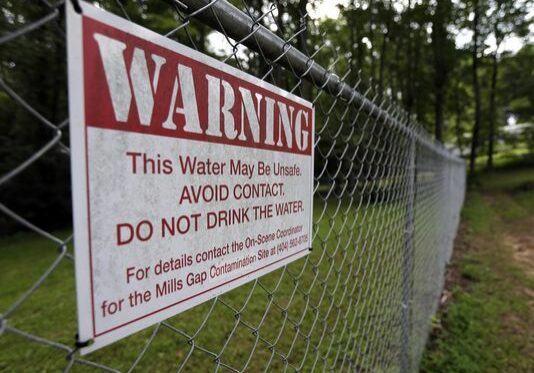New Jersey has over 18,000 known contaminated sites under remediation and tens of thousands of additional sites that have been cleaned up to some degree but still need to be watched. Some of our state’s 3,600 public and private school buildings sit on or near these sites where problem pollutants were dumped, spilled, leaked, or intentionally used. Pollutants may include:
- Heating oil, diesel fuel, and gasoline from leaking underground storage tanks
- Solvents and other Volatile Organic Compounds (VOCs) from dry cleaners and factories
- Pesticides and herbicides from agricultural uses
- Lead and other heavy metals, polychlorinated biphenyls (PCBs), asbestos, polycyclic aromatic hydrocar- bons (PAHs), and more, often from old factories
- “Historic fill” – construction debris, dredge spoils, incinerator residue, demolition debris, fly ash, or other solid waste that can contain contaminants
The number of schools on or near contaminated sites is not known. The New Jersey Department of Environmental Protection (DEP) does not maintain a separate inventory of such K-12 schools. The DEP maintains a Known Contaminated Sites (KCS) list on its website, but additional unknown contaminated sites are certain to exist. DEP can provide any known information about specific school sites upon request.
If a school is on or near a toxic site, it does not necessarily mean that staff and students are endangered. What it does mean is that the local association should investigate the situation to see if it necessitates remediation. The purpose of remediation is to prevent human exposure to contaminants in soil and groundwater that can occur on playgrounds and playing fields. Exposures may also occur through the ingestion of well water or when chemicals or their volatile vapors travel through the soil and enter the school through the foundation, crawl space, or slab.
Local associations affected
In the past year, three local associations worked through their UniServ field representatives to obtain technical assistance on site cleanup from New Jersey Work Environment Council (WEC) industrial hygienist Adrienne Markowitz.
A vapor removal system was put in place at Atlantic Highlands Elementary School to stop the intrusion of vapors from benzene, toluene, the gasoline additive MTBE, and other gasoline ingredients. The Atlantic High- lands Education Association asked for monitoring to ensure the remediation was effective. Leaking under- ground fuel storage tanks were removed from all 19 public schools in Cherry Hill beginning in the 1990s. Concerns about possible remaining pollutants surfaced due to illnesses among school staff and lack of post-removal testing and closure reports. The Cherry Hill Education Association and the Educational Assistants of Cherry Hill insisted that the district produce documentation regarding the remediation of the sites.
Soil contaminated with historic fill containing VOCs, fly ash, PAHs, and lead was removed from the new playground of the Martin Luther King, Jr. Middle School’s Lester Rutland Resource Center in Paterson during the summer of 2010. A multilayered barrier was installed and a restriction was placed on the deed. The Paterson Education Association monitored and observed the process.
Remediation methods
Local associations, staff, and parents should insist on the best remedies for contaminated sites, advocating for actions listed here. These methods can be costly, so beware of recommendations for less effective measures, even if they come from the DEP.
Soil
- Ideally, all soil contaminated above residential cleanup standards should be removed, but at least two feet of contaminated soil should be removed or treated.
- Remove or treat deeper “hot spots” that are far above cleanup standards.
- Remove leaking tanks, don’t just fill them with sand.
- Install a multilayered barrier over any remaining contamination, that includes:
- A cap of asphalt or certifiably clean top- soil planted with drought-resistant grass
- A bright orange geotextile fabric marker to warn against digging
- Twelve to 24 inches of quarry rock as a capillary break to limit upward or downward movement of water
Groundwater
- Pump and treat system to continuously remove, treat, and recycle groundwater.
- Blow air into the groundwater to strip out contaminants.
- Inject chemicals to neutralize or oxidize contaminants.
- Inject microorganisms to biodegrade organic constituents.
- Waiting for the contamination to go away on its own, known as natural attenuation, is the least effective method of remediation.
Vapor intrusion
- Build a subsurface depressurization system consisting of PVC pipes installed through the slab floor and a connected fan. The fan applies a vacuum beneath the slab and the vapors in the soil are piped outside before they enter the school.
- Install a new foundation consisting of a two-foot concrete slab on a polyethylene vapor barrier.
Long-term management
- Keep records of the history of site uses, environmental evaluation and sampling procedures, remedial actions, and the steps needed to maintain the site.
- Post activities that are prohibited at the site, such as digging or sports.
- Train school staff to check monthly for cracks in foundations and breaches of caps.
- Train staff to operate and maintain subsurface depressurization systems.
- If VOCs were found in the soil or groundwater, install monitoring wells under or as close to the school building as possible. Samples should be taken and analyzed for a wide range of VOCs every six months.
- Ensure that institutional controls are in place. These are the legal and administrative protocols used to protect the integrity of the remedy, including deed restrictions on the land use, zoning, and easements.
Government oversight
DEP site remediation changes that went into effect in May 2009 created Licensed Site Remediation Professionals (LSRP) to perform site investigations and conduct remedial actions. The DEP issues a Response Action Outcome (RAO), which is the LSRP’s writ- ten professional opinion that a location was remediated in accordance with applicable statutes, regulations, and guidance. The DEP also audits some cases and reviews all cases with potential impacts on humans and environmentally sensitive natural resources and where contaminants may migrate off the site. The DEP has the final say on remedy selection. Sometimes polluters are found and made to pay for remediation.
